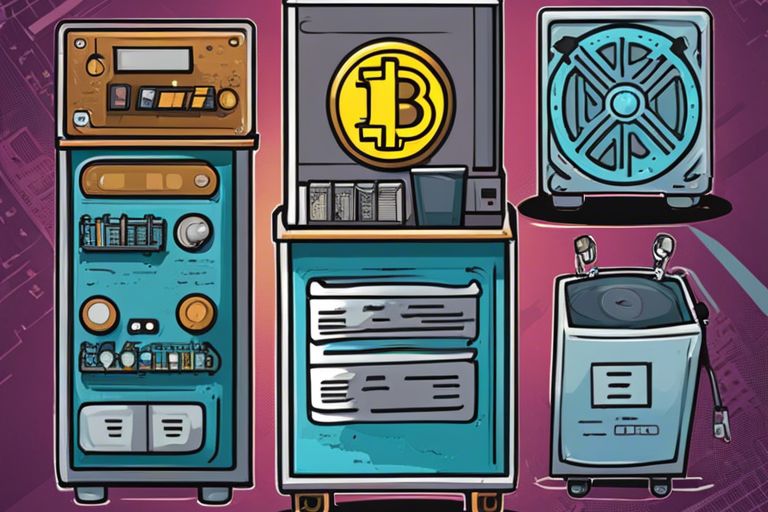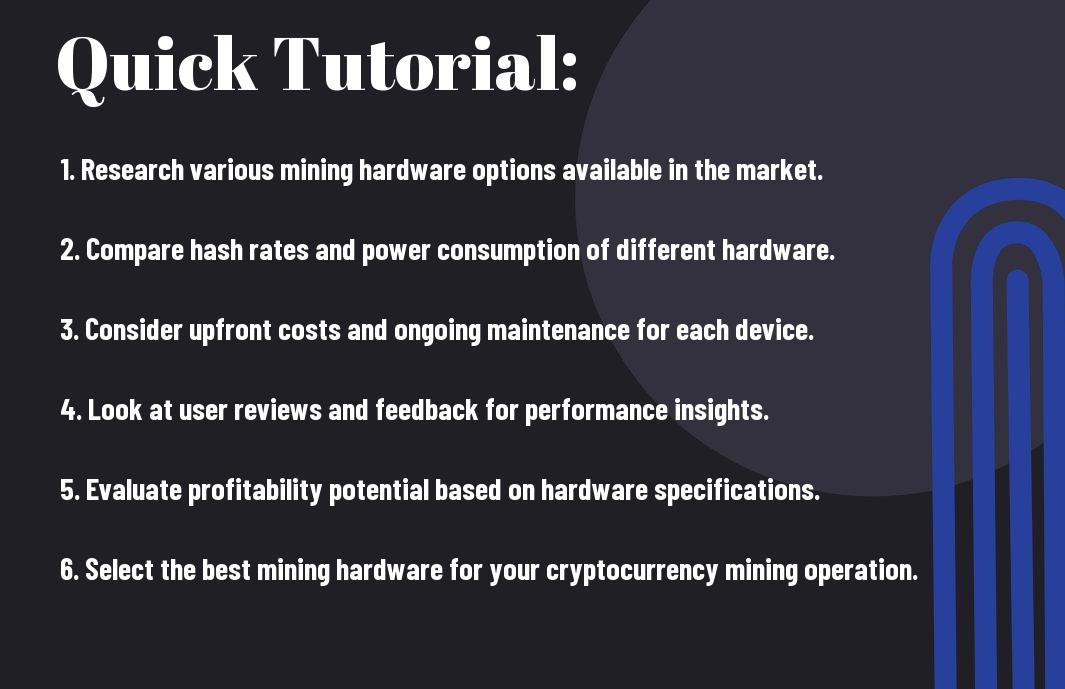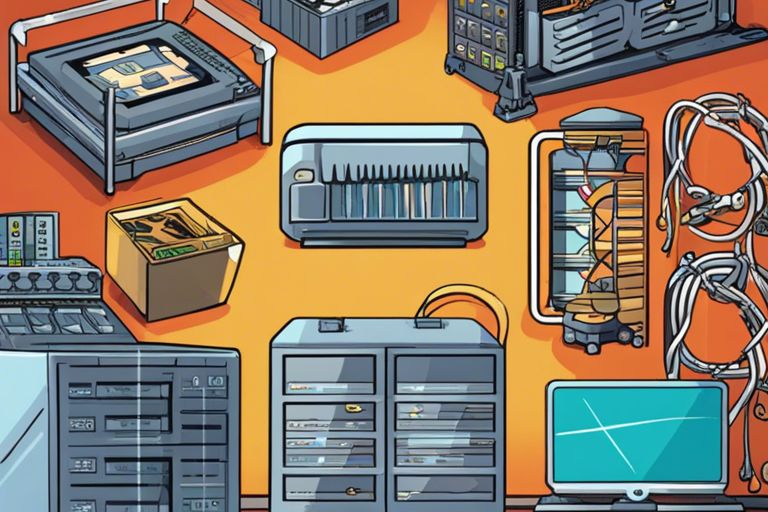Are you ready to examine the world of cryptocurrency mining, but not sure which hardware to choose? With so many options available, it can be overwhelming to decide which one is right for you. In this tutorial, we’ll break down the top cryptocurrency mining hardware options, comparing their performance, power consumption, and price. You’ll learn how to make an informed decision based on your specific needs and budget. From ASIC miners to GPU rigs, we’ll cover it all, so you can start mining your favorite cryptocurrency with confidence.
Key Takeaways:
- Hash Rate is a critical factor in cryptocurrency mining hardware comparison. A higher hash rate means a higher chance of solving complex mathematical equations and earning rewards. When comparing mining hardware, look for the highest hash rate per unit of power consumed.
- Power Consumption is a significant consideration in cryptocurrency mining hardware comparison. Miners need to balance high hash rates with low power consumption to minimize electricity costs and maximize profits. Look for hardware with high efficiency ratings (e.g., high hash rate per watt) to optimize your mining operation.
- Cost and ROI are important factors in cryptocurrency mining hardware comparison. Calculate the total cost of ownership, including the initial investment, operating expenses, and expected returns. Compare the ROI of different mining hardware options to determine which one offers the best value for your investment.

Understanding Cryptocurrency Mining
While delving into the world of cryptocurrency mining, it’s vital to understand the basics of this complex process.
What is Cryptocurrency Mining?
Any individual who wants to participate in the cryptocurrency ecosystem must first comprehend what cryptocurrency mining entails. In simple terms, cryptocurrency mining is the process of verifying transactions on a blockchain network, ensuring the integrity and security of the network, and being rewarded with a certain amount of cryptocurrency in return.
Types of Cryptocurrency Mining
To grasp the concept of cryptocurrency mining, you need to familiarize yourself with the different types of mining methods. There are several ways to mine cryptocurrencies, including:
- CPU Mining: Using your computer’s central processing unit (CPU) to mine cryptocurrencies.
- GPU Mining: Utilizing your computer’s graphics processing unit (GPU) to mine cryptocurrencies.
- ASIC Mining: Employing application-specific integrated circuit (ASIC) devices designed specifically for cryptocurrency mining.
- Cloud Mining: Renting computing power from cloud mining services to mine cryptocurrencies.
- Pool Mining: Joining a group of miners to pool your resources and increase your chances of solving complex mathematical equations.
Recognizing the different types of cryptocurrency mining methods is crucial in determining the most suitable approach for your needs.
| Mining Method | Description |
| CPU Mining | Using your computer’s central processing unit (CPU) to mine cryptocurrencies. |
| GPU Mining | Utilizing your computer’s graphics processing unit (GPU) to mine cryptocurrencies. |
| ASIC Mining | Employing application-specific integrated circuit (ASIC) devices designed specifically for cryptocurrency mining. |
| Cloud Mining | Renting computing power from cloud mining services to mine cryptocurrencies. |
Mining cryptocurrencies can be a lucrative venture, but it’s vital to understand the different types of mining methods and their requirements. You need to consider factors such as electricity costs, hardware investments, and difficulty levels before deciding which mining method suits you best. Recognizing the pros and cons of each method will help you make an informed decision and maximize your returns.
Key Factors to Consider When Choosing Mining Hardware
Now that you’re considering investing in cryptocurrency mining, it’s crucial to evaluate the key factors that will impact your mining experience. These factors will help you make an informed decision and ensure you get the most out of your mining hardware.
Here are the key factors to consider:
- Hash Rate and Performance
- Power Consumption and Efficiency
- Cost and ROI
The right balance of these factors will determine the success of your mining operation.
Hash Rate and Performance
Adequate hash rate and performance are crucial for solving complex mathematical equations and earning cryptocurrency rewards. Look for mining hardware with a high hash rate, measured in hashes per second (H/s), to increase your chances of solving blocks and earning rewards.
Power Consumption and Efficiency
Rate of power consumption is a critical factor in determining your mining costs. Mining hardware with high power efficiency, measured in watts per hash (W/TH), will help reduce your electricity bills and increase your profitability.
When choosing mining hardware, consider the total cost of ownership, including the initial investment and ongoing power costs. A mining rig with high power efficiency will save you money in the long run and reduce your environmental impact.
Cost and ROI
Performance and profitability are closely tied to the cost of your mining hardware. Calculate your return on investment (ROI) by considering the initial cost, power consumption, and expected earnings. Aim for a mining rig that provides a reasonable ROI to ensure your investment pays off.
This is where you need to crunch the numbers and consider the total cost of ownership, including the initial investment, power costs, and maintenance expenses. A mining rig with a high ROI will help you recoup your investment quickly and increase your earnings.
CPU Mining Hardware Comparison
To get started with CPU mining, you’ll need a powerful processor that can handle the complex calculations involved in cryptocurrency mining. In terms of choosing the right CPU for mining, you have two main options: AMD Ryzen and Intel Core processors.
AMD Ryzen vs. Intel Core Processors
Now, let’s take a closer look at the key differences between AMD Ryzen and Intel Core processors for CPU mining. The main advantage of AMD Ryzen processors is their higher core count and thread count, which makes them better suited for multi-threaded applications like cryptocurrency mining.
Comparison of AMD Ryzen and Intel Core Processors
| AMD Ryzen | Intel Core |
|---|---|
| Higher core count and thread count | Higher single-thread performance |
| Better suited for multi-threaded applications | Better suited for single-threaded applications |
Performance and Power Consumption Comparison
An important factor to consider when choosing a CPU for mining is its performance and power consumption. You want a CPU that can deliver high hash rates while keeping power consumption low to minimize your electricity costs.
Performance and Power Consumption Comparison
| CPU Model | Hash Rate (H/s) | Power Consumption (W) |
|---|---|---|
| AMD Ryzen 9 5900X | 350 | 125 |
| Intel Core i9-11900K | 250 | 95 |
Comparison of the performance and power consumption of different CPU models shows that AMD Ryzen processors generally offer higher hash rates at the cost of higher power consumption. However, it’s necessary to consider your specific mining setup and electricity costs when choosing a CPU. Additionally, be aware of the potential for overheating and damage to your CPU if you’re not using a proper cooling system.
GPU Mining Hardware Comparison
Despite the rise of ASIC miners, GPU mining remains a popular choice for many cryptocurrency enthusiasts. If you’re looking for the best bitcoin mining hardware, you can check out resources like The Best Bitcoin Mining Machines in 2024… – CoinLedger. Regarding GPU mining, the two main contenders are NVIDIA GeForce and AMD Radeon graphics cards. Here’s a breakdown of how they compare:
| NVIDIA GeForce | AMD Radeon |
|---|---|
| Higher performance in certain algorithms | Lower power consumption and cost |
| Better compatibility with certain mining software | Higher memory bandwidth and capacity |
NVIDIA GeForce vs. AMD Radeon Graphics Cards
Assuming you’re new to GPU mining, you might be wondering which brand to choose. NVIDIA GeForce cards tend to be more expensive, but offer higher performance in certain algorithms. AMD Radeon cards, on the other hand, offer lower power consumption and cost, making them a more accessible option for beginners.
Performance and Power Consumption Comparison
| GPU Model | Hash Rate (MH/s) | Power Consumption (W) |
|---|---|---|
| NVIDIA GeForce RTX 3080 | 60-70 | 260-300 |
| AMD Radeon RX 6800 XT | 40-50 | 190-220 |
Any serious miner knows that performance and power consumption are crucial factors to consider. As you can see from the table above, NVIDIA GeForce cards tend to offer higher hash rates, but at the cost of higher power consumption. AMD Radeon cards, on the other hand, offer lower power consumption, but slightly lower hash rates.
Power consumption is a critical factor to consider, as it directly affects your electricity costs and overall profitability. Be sure to calculate your power consumption and factor it into your mining costs.
Memory and Bandwidth Considerations
| GPU Model | Memory (GB) | Memory Bandwidth (GB/s) |
|---|---|---|
| NVIDIA GeForce RTX 3080 | 12 | 616 |
| AMD Radeon RX 6800 XT | 16 | 448 |
There’s more to GPU mining than just hash rates and power consumption. Memory and bandwidth considerations are also crucial, as they affect the performance of your mining rig. AMD Radeon cards tend to offer higher memory capacity and bandwidth, making them well-suited for certain algorithms.
Mining algorithms that require high memory bandwidth, such as Ethash, may benefit from AMD Radeon cards. On the other hand, algorithms that require high processing power, such as SHA-256, may benefit from NVIDIA GeForce cards. Be sure to research the specific requirements of your chosen algorithm to optimize your mining setup.
Important note: Always consider your specific mining setup and goals when choosing GPU mining hardware. Be cautious of overheating and power supply issues, and make sure to follow proper safety guidelines when building and operating your mining rig.
ASIC Mining Hardware Comparison
Once again, when it comes to ASIC mining hardware, you’re spoiled for choice. Two of the most popular options are Bitmain’s Antminer series and Innosilicon’s T2 Turbo series. Let’s investigate a comparison of these two heavy-hitters.
Bitmain Antminer vs. Innosilicon T2 Turbo
If you’re looking for a reliable and efficient ASIC miner, you can’t go wrong with either of these options. Here’s a brief comparison:
| Feature | Bitmain Antminer | Innosilicon T2 Turbo |
|---|---|---|
| Hash Rate | Up to 14 TH/s | Up to 24 TH/s |
| Power Consumption | Up to 1375W | Up to 1980W |
| Algorithm | SHA-256 | SHA-256 |
Performance and Power Consumption Comparison
Assuming you’re looking for the best bang for your buck, here’s a comparison of the performance and power consumption of these two ASIC miners:
| Model | Hash Rate (TH/s) | Power Consumption (W) |
|---|---|---|
| Bitmain Antminer S17 Pro | 56 | 1975 |
| Innosilicon T2 Turbo-24T | 24 | 1980 |
A closer look at the performance and power consumption of these two ASIC miners reveals that the Bitmain Antminer S17 Pro offers a higher hash rate at a similar power consumption level. However, the Innosilicon T2 Turbo-24T is still a strong contender, offering a competitive hash rate at a lower price point.
Noise and Heat Dissipation Considerations
Heat dissipation is a critical consideration when it comes to ASIC mining hardware. You’ll want to ensure that your miner is operating at a safe temperature to prevent overheating and prolong its lifespan.
| Model | Noise Level (dB) | Operating Temperature (°C) |
|---|---|---|
| Bitmain Antminer S17 Pro | 75 | 5-40 |
| Innosilicon T2 Turbo-24T | 70 | 0-40 |
Considerations such as noise level and operating temperature are crucial when choosing an ASIC miner. Both the Bitmain Antminer S17 Pro and Innosilicon T2 Turbo-24T operate at relatively high noise levels, but the Innosilicon T2 Turbo-24T has a slightly lower noise level. Additionally, both miners have a wide operating temperature range, ensuring that they can operate safely in a variety of environments.
Important Note: Always ensure that your ASIC miner is operating in a well-ventilated area and that you’re following proper safety precautions to prevent overheating and electrical shock.
FPGA Mining Hardware Comparison
Unlike other types of cryptocurrency mining hardware, Field-Programmable Gate Arrays (FPGAs) offer a unique combination of performance, power efficiency, and customization options. When choosing an FPGA mining hardware, you’ll need to consider several factors, including the type of FPGA solution, performance, power consumption, and programmability.
Xilinx vs. Intel FPGA Solutions
Solutions from Xilinx and Intel are two of the most popular FPGA options for cryptocurrency mining. The main difference between them lies in their architecture and design. Xilinx FPGAs are known for their high-performance and low-power consumption, making them suitable for complex algorithms and high-hash-rate cryptocurrencies. Intel FPGAs, on the other hand, offer better programmability and customization options, making them ideal for miners who need to adapt to changing mining conditions.
FPGA Solution Comparison
| Xilinx FPGAs | Intel FPGAs |
|---|---|
| High-performance and low-power consumption | Better programmability and customization options |
| Suitable for complex algorithms and high-hash-rate cryptocurrencies | Ideal for miners who need to adapt to changing mining conditions |
Performance and Power Consumption Comparison
Even the most experienced miners struggle to find the perfect balance between performance and power consumption. FPGAs offer a unique advantage in this regard, as they can be optimized for specific mining algorithms and cryptocurrencies.
Performance and Power Consumption Comparison
| Xilinx FPGAs | Intel FPGAs |
|---|---|
| Up to 500 MH/s hash rate | Up to 300 MH/s hash rate |
| Power consumption as low as 50W | Power consumption as low as 30W |
The performance and power consumption of FPGAs can vary greatly depending on the specific model and mining algorithm used. However, in general, Xilinx FPGAs offer higher hash rates, while Intel FPGAs consume less power.
Programmability and Customization Options
Power users will appreciate the high level of programmability and customization options offered by FPGAs. With the right tools and expertise, you can optimize your FPGA for specific mining algorithms, adjust clock speeds, and even create custom firmware.
Programmability and Customization Options
| Xilinx FPGAs | Intel FPGAs |
|---|---|
| Support for Vitis and Vivado development tools | Support for Quartus II and OpenCL development tools |
| Customizable clock speeds and voltage settings | Customizable clock speeds and voltage settings |
Customization is key when it comes to getting the most out of your FPGA mining hardware. By tailoring your FPGA to your specific mining needs, you can achieve higher hash rates, lower power consumption, and increased profitability. However, keep in mind that customization requires a high level of expertise and can be risky if not done correctly.
Tutorial: Choosing the Right Mining Hardware for Your Needs
After considering the different types of cryptocurrency mining, it’s time to choose the right mining hardware for your needs. This tutorial will guide you through the process of selecting the perfect mining hardware for your goals and budget.
Step 1: Determine Your Budget and Goals
One of the most critical factors in choosing mining hardware is determining your budget and goals. You need to decide how much you’re willing to invest in your mining operation and what you want to achieve. Are you looking to mine a specific cryptocurrency, or do you want to diversify your portfolio? Knowing your budget and goals will help you narrow down your options and make an informed decision.
Step 2: Research and Compare Mining Hardware Options
Now that you have a clear idea of your budget and goals, it’s time to research and compare mining hardware options. You can start by creating a table to compare the different features of each hardware option.
| Feature | Description |
|---|---|
| Hash Rate | The speed at which the hardware can perform calculations |
| Power Consumption | The amount of energy required to operate the hardware |
| Memory | The amount of memory available for storing data |
| Compatibility | The type of cryptocurrency the hardware is compatible with |
Mining hardware options vary greatly, and it’s crucial to compare their features to find the best fit for your needs. Consider factors such as hash rate, power consumption, memory, and compatibility when making your decision.
Step 3: Consider Additional Factors and Make a Decision
Factors such as noise level, cooling system, and warranty should also be taken into account when choosing mining hardware. Make a list of the pros and cons of each option to help you make a well-informed decision.
- Noise Level: Will the hardware be too loud for your workspace?
- Cooling System: Does the hardware have an efficient cooling system to prevent overheating?
- Warranty: What kind of warranty does the manufacturer offer?
The right mining hardware can make all the difference in your cryptocurrency mining operation. By considering these additional factors, you can ensure that you’re making the best decision for your needs.
Compare your options carefully, and don’t hesitate to reach out to the manufacturer or online communities for more information. The right mining hardware is out there, and with these steps, you’ll be well on your way to finding it.

Summing up
To wrap up, you’ve now got a comprehensive understanding of the various cryptocurrency mining hardware options available to you. You’ve seen how different components, such as GPUs and ASICs, stack up against each other in terms of performance, power consumption, and cost. With this knowledge, you’re equipped to make an informed decision about which hardware best fits your mining needs and budget. By choosing the right hardware, you’ll be well on your way to maximizing your cryptocurrency mining returns.
FAQ
Q: What are the key factors to consider when comparing cryptocurrency mining hardware?
A: When comparing cryptocurrency mining hardware, there are several key factors to consider. These include the hash rate, power consumption, and cost of the hardware. The hash rate refers to the number of calculations per second that the hardware can perform, and is usually measured in GH/s (gigahashes per second) or TH/s (terahashes per second). Power consumption is important because it affects the cost of electricity and the heat generated by the hardware. The cost of the hardware is also a crucial factor, as it can vary significantly depending on the type and quality of the hardware. Additionally, other factors such as the type of cryptocurrency being mined, the cooling system, and the noise level should also be considered.
Q: How do ASIC miners compare to GPU miners in terms of performance and efficiency?
A: ASIC (Application-Specific Integrated Circuit) miners are specifically designed for cryptocurrency mining and offer higher performance and efficiency compared to GPU (Graphics Processing Unit) miners. ASIC miners are designed to perform a specific task, such as SHA-256 or Scrypt, and are therefore much faster and more efficient than GPU miners. They also consume less power and produce less heat than GPU miners. However, ASIC miners are typically more expensive than GPU miners and are limited to mining a specific algorithm. GPU miners, on the other hand, are more versatile and can be used for other tasks such as gaming and video editing, but are generally less efficient and more expensive to operate.
Q: What are some popular cryptocurrency mining hardware options and their specifications?
A: Some popular cryptocurrency mining hardware options include the Antminer S19 Pro, Innosilicon T2 Turbo, and Nvidia GeForce RTX 3080. The Antminer S19 Pro has a hash rate of 110 TH/s, power consumption of 3250W, and costs around $2,000. The Innosilicon T2 Turbo has a hash rate of 24 TH/s, power consumption of 1980W, and costs around $1,000. The Nvidia GeForce RTX 3080 has a hash rate of around 5-6 MH/s, power consumption of 260W, and costs around $1,000. It’s worth noting that the specifications and prices of these hardware options can vary depending on the retailer and availability.


Hello. I think it’s not very cheap to get into this crypto mining thing. I could just be my opinion though. It’s also a lot harder to mine than I think people realize. As in can take more time. And a lot of the people doing this are people with big money so it’s hard to compete against them as well. But I could be wrong.
Hello, Jake! You bring up some valid points. Crypto mining can indeed require a significant investment in hardware and electricity. It’s not always as simple as it seems, and the competition can be tough, especially against those with substantial financial resources. That said, there are alternative ways to participate in the crypto space that might be more accessible. Thanks for sharing your thoughts!
#CryptoMining #Investment #Competition #CryptoCommunity #Blockchain